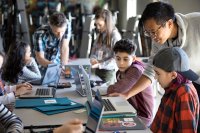Putting Learning First With New Tech Tools
Five areas you can focus on to ensure that the digital tools transforming education serve your learning objectives.
Your content has been saved!
Go to My Saved Content.It’s wild to think about how new technologies are changing the way we think about teaching and learning. The digital tools many students have access to both inside and outside the classroom require us all to take a hard look at the way we use these tools in the context of learning experiences. It’s easy to get caught up with the shiniest, brightest, or most attention-grabbing digital device or website, but it is possible to pause, reflect, and prioritize tasks over digital tools in the classroom. Are we putting the learning first?
Designing rigorous learning experiences in a tech-rich classroom requires us to take a step back and think about the ways technology can elevate and energize students. Prioritizing learning experiences means identifying our objectives and pausing to explore how digital tools can help students dive into these learning experiences like never before.
Digital tools let students collaborate in new ways, question the world around them, connect their work with the world, create products that demonstrate their understanding, and wonder about new topics they encounter. These strategies can help you integrate technology into a lesson as you design learning activities.
Collaborating
Although digital tools have changed the way we think about creating in the classroom, collaboration means more than accessing the same document from different devices. Students can work together as they dive into new content and apply what they’ve learned in the classroom.
You might ask students to log in to a shared presentation outside of school hours to combine their research efforts in one place. Remote collaboration on a shared document is powerful and gives students a new way to provide feedback to one another. Designing learning activities that leverage the collaborative nature of digital tools allows students to explore a topic while sitting in different classrooms or time zones.
And when students share a screen—leaning over to discuss, record, and dive into media together—they also build transferable skills. This shared-screen collaboration gives students an opportunity to compromise, work toward a common goal, and think critically as they dive into course content with their peers.
Questioning
Typing a question into a search bar won’t always give students the full answer. We can leverage the power of digital tools to help students explore the world and answer questions that haven’t been asked yet or don’t have one correct answer. These deep-dive questions require educators to model their own searches and strategies for evaluating websites and online resources.
Modeling how to evaluate sources to find the answer to deep-dive questions is important for students to develop in any subject area, for any learning objective. As students navigate the internet from a personal or school device, we can create experiences for them to pose questions, share their findings, and build an appreciation of lifelong learning online.
Connecting
An authentic audience breathes life into both tech-rich and low-tech tasks. What makes the use of technology especially powerful is how digital tools can connect students with readers, listeners, and viewers of their work.
Using online spaces to share student work with the world helps students connect their learning with an audience. Students can tweet a video they’ve created to share their opinion about a novel, or share the steps to solve a math problem on a classroom blog.
Creating
Open-ended creation tools give students a space to demonstrate their understanding. They can capture their voice, record video, and tell the story of their learning. A tool like Spark Video might be perfect for students to narrate images they’ve collected during a community walk as they create a public service announcement to share with their school board. Helping students determine the product for that will showcase their learning can take many forms.
Students who are going to share their new knowledge about a topic might use an audio tool like Soundtrap to create a podcast, and ones who will gather a handful of videos they recorded during a science experiment might use Book Creator to share their learning. Focusing on the features students need in order to share their learning with the world can help us place tasks before apps.
Wondering
Providing a safe space to ask questions gives purpose to learning activities inside the classroom. Students have interests they can explore in the context of your learning goals. They might wonder why some animals are endangered and others are not, or they might wonder why an author chose to write about a topic.
Digital tools can help students discover new things, explore topics that pique their curiosity, and empower them as content consumers and creators. As they wonder about the world around them, students have access to online resources to help them harness their curiosity.
As you work to prioritize learning experiences over technology this school year, pause to ask:
- At the end of this learning experience, what should students understand?
- How will I know for sure if students understand?
- What would I like students to accomplish?
In my new book, Tasks Before Apps: Designing Rigorous Learning in a Tech-Rich Classroom, I share more strategies for placing learning goals front and center and dive into creation, collaboration, and curiosity in the classroom.
